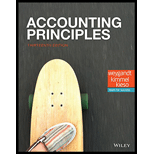
a)
Introduction: Cost of goods manufactured refers to the overall
To calculate: The cost of goods manufactured as on December 31, 2020.
b)
Introduction: An income statement is prepared by the business organizations to know how much amount of gross profit or net profit they earn during the year. An income statement's objective is to display a company's financial success over a specific time frame.
To prepare: The income statement through gross profit.
Introduction: The
To Present: The ending inventory in the balance sheet as on December 31, 2020.
Introduction: The balance sheet of an organization shows the financial situation as of a particular date. The balance sheet is used by the investors, and management to assess the financial position of the company. To state: The difference between the balance sheet and income statement of a merchandising company and manufacturing company.
Want to see the full answer?
Check out a sample textbook solution
Chapter 19 Solutions
EBK ACCOUNTING PRINCIPLES
- Which of the following represents the components of the income statement for a manufacturing business? A. Sales Revenue - Cost of Goods Sold = gross profit B. Service Revenue - Operating Expenses = gross profit C. Service Revenue - Cost of Goods Manufactured = gross profit D. Sales Revenue - Cost of Goods Manufactured = gross profitarrow_forwardWhich of the following represents the components of the income statement for a service business Sales Revenue - Cost of Goods Sold = gross profit Service Revenue - Operating Expenses = operating income Sales Revenue - Cost of Goods Manufactured = gross profit Service Revenue - Cost of Goods Purchased = gross profitarrow_forwardHow does the Cost of goods sold section of the income statement differ between retail and manufacturing companies?arrow_forward
- 3. The subtotal, "Cost of goods manufactured" appears on a a merchandising company's income statement. b. a manufacturing company's income statement. c. both a manufacturing and a merchandising company's income statement. d. neither a merchandising nor a manufacturing company's income statement.arrow_forwardView Policies Current Attempt in Progress You have the following information for Oriole Diamonds. Oriole Diamonds uses the periodic method of accounting for its inventory transactions. Oriole only carries one brand and size of diamonds-all are identical. Each batch of diamonds purchased is carefully coded and marked with its purchase cost. March 1 Beginning inventory 177 diamonds at a cost of €362 per diamond. March 3 Purchased 236 diamonds at a cost of €413 each. March 5 Sold 220 diamonds for €708 each. March 10 Purchased 413 diamonds at a cost of €456 each. March 25 Sold 472 diamonds for €767 each. (a) Assume that Oriole Diamonds uses the specific identification cost flow method. (1) Demonstrate how Oriole Diamonds could maximize its gross profit for the month by specifically selecting which diamonds to s To maximize gross profit, Oriole Diamonds should sell the diamonds with the Demonstrate how Oriole Diamonds could minimize its gross profit for the month by selecting which diamonds…arrow_forwardPrepare a proper title for the annual schedule of cost of goods manufactured of Google. Does the date match the balance sheet or income statement Why?arrow_forward
- please answer within the format by providing formula the detailed workingPlease provide answer in text (Without image)Please provide answer in text (Without image)Please provide answer in text (Without image)arrow_forwardYou have the following information for Wildhorse Gems. Wildhorse uses the periodic system of accounting for its inventory transactions. Wildhorse only carries one brand and size of diamonds-all are identical. Each batch of diamonds purchased is carefully coded and marked with its purchase cost. March 1 March 31 March 5: March 10- March 25 Beginning inventory 150 diamonds at a cost of $320 per diamond. Purchased 200 diamonds at a cost of $360 each. Sold 180 diamonds for $630 each. Purchased 350 diamonds at a cost of $385 each. Sold 395 diamonds for $680 each.arrow_forwardDirections: Read the given sentences carefully. Select the best answer from the choices given below. Write your answer on the space provided before each item. Gains Purchases Sales Income Gross Profit Sales Discount Selling expenses Professional Fee Net Income Operating expenses Sales return Cost of Goods Sold Service Income 1. An example of service revenue. 2. The revenue generated from the sale of products. 3. It is computed by deducting the cost of sales from net sales. 4. It is used to describe revenue derived from the rendering of services. 5. A type of income derived from the other activities of the business. 6. The account used to report the acquisitions of merchandise for sale. 7. It represents the actual cost of inventories that the company was able to sell. 8. These are expenses that are directly related to the main purpose of a merchandising business 9. A contra-sales account that is used to report the amount of discount given to or taken by the customers. 10. It refers…arrow_forward
- Which product costs appear on the balance sheet?a. goods that are partially completed at end of periodb. goods that are unsold at end of periodc. goods of merchandising business onlyd. A and B are correctarrow_forwardPlease answer all. Thankyouarrow_forwardI. The Cost of Goods Sold of a Merchandising company will include cost of Materials, Labor and Factory Overhead. II. A Merchandising company's Cost of Goods Sold will include Purchases.A. Statement I is false while statement II is true.B. Both statements are true.C. Both statements are false.D. Statement I is true while statement II is false.arrow_forward
 Managerial AccountingAccountingISBN:9781337912020Author:Carl Warren, Ph.d. Cma William B. TaylerPublisher:South-Western College Pub
Managerial AccountingAccountingISBN:9781337912020Author:Carl Warren, Ph.d. Cma William B. TaylerPublisher:South-Western College Pub Financial And Managerial AccountingAccountingISBN:9781337902663Author:WARREN, Carl S.Publisher:Cengage Learning,Principles of Accounting Volume 1AccountingISBN:9781947172685Author:OpenStaxPublisher:OpenStax College
Financial And Managerial AccountingAccountingISBN:9781337902663Author:WARREN, Carl S.Publisher:Cengage Learning,Principles of Accounting Volume 1AccountingISBN:9781947172685Author:OpenStaxPublisher:OpenStax College- Principles of Accounting Volume 2AccountingISBN:9781947172609Author:OpenStaxPublisher:OpenStax College
 College Accounting (Book Only): A Career ApproachAccountingISBN:9781305084087Author:Cathy J. ScottPublisher:Cengage Learning
College Accounting (Book Only): A Career ApproachAccountingISBN:9781305084087Author:Cathy J. ScottPublisher:Cengage Learning Principles of Cost AccountingAccountingISBN:9781305087408Author:Edward J. Vanderbeck, Maria R. MitchellPublisher:Cengage Learning
Principles of Cost AccountingAccountingISBN:9781305087408Author:Edward J. Vanderbeck, Maria R. MitchellPublisher:Cengage Learning





